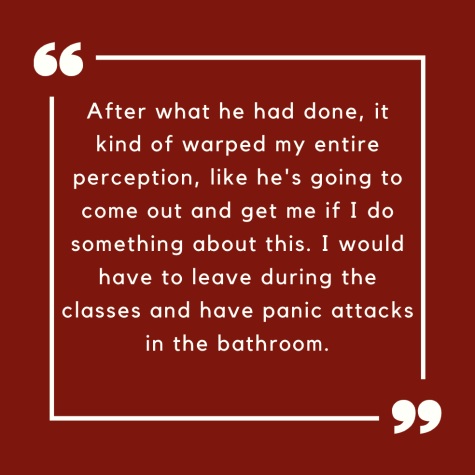The weight of Title IX
Examining the process and emotional turmoil of reporting sexual assault at MVHS
Despite the immense detail of Title IX, victims of sexual assault may feel lost and disoriented during the reporting process.
April 5, 2023
Content warning: This story contains descriptions of sexual assault.
The student source in this story is anonymous due to safety concerns and will be referred to as Student A.
It may start as an intimate moment, a reciprocation of affection between two individuals. Other times, the victim is thrust straight into it, a shock they weren’t ever prepared for. Ultimately, the outcome is the same: the feeling of perpetual helplessness, of being destroyed emotionally and physically, of personal violation beyond imagination.
“He started doing what he was doing and making sexual contact with me without asking me,” Student A said. “At first, you kind of sit there in shock, but then I realized what was happening, and I quite physically tried to move away. I tried to turn around and put my hands up, and he literally, like physically, restrained me from trying to get away.”
Sexual harassment is defined as uninvited sexual conduct, such as sexual advances, verbal harassment and unsolicited sharing of sexual material. Sexual assault includes sexual actions performed intentionally without consent through coercion or forceful measures. Both are included under the federal civil rights law, Title IX, which protects individuals in educational settings from sexual misconduct and sex-based discrimination. According to the Rape, Abuse & Incest National Network (RAINN), out of all sexual assault victims under the age of 18, 66% are between 12 and 17 years old, and 57,329 children were victims of sexual abuse in FY16 alone.
In the state of California, standard procedures to report sexual assault include providing a written account of the event, any supporting evidence and witness perspectives in a report filed to the police. An investigation commences once law enforcement decides the evidence is sufficient to proceed with pursuing charges against the offender. FUHSD’s Title IX & Gender Equity page defines sexual harassment under Title IX as a list of conducts which, when experienced by a victim, can be reported in a formal complaint. Any person can file a formal complaint to Title IX coordinator Trudy Gross on behalf of a victim and expect prompt investigation provided by the district. According to Assistant Principal Nico Flores, MVHS offers a student safety report — an online form that promises confidentiality and a further response from administration.
“Let’s say that you’re at home, and it’s nine o’clock, and you really need to tell somebody — [the form] gives you the opportunity to do that,” Flores said. “It would allow you to at least get that out. Then we could follow up and make sure that they’re cared for, that they’re feeling supported and that we’re following the law as well.”
One of the first steps in the reporting process is to involve legal enforcement, and an officer will typically question a victim about the exact events. This process, known as Trauma-Informed Victim Interviewing, is a key step in the investigation, as it helps establish the facts and circumstances of the reported sexual assault. According to the International Association of Chiefs of Police, typical questioning conventions include using open-ended questions and creating a supportive environment that encourages a victim to open up without feeling as though they are at fault for their actions. However, the invasive nature of the questions, regardless of precautions taken to reduce their impact, can cause victims to relive their trauma and experience emotional distress.
“It was really a terrible process because you have to sit there with somebody you don’t know at all, and they ask you all these really invasive questions about every single detail of what happened,” Student A said. “A few of them were exact. Not just [the] exact placement of hands or body or whatever, but like, ‘how many, how much pressure?’ That was the part that was hard to deal with.”

However, school-based therapist Leila Lurie emphasizes the need for such questions in the investigative process, because it helps law enforcement get to the root of the assault and deliver the appropriate consequences.
“Part of it is asking those explicit questions, and it is horrible and is really traumatizing,” Lurie said. “It’s necessary. It’s an unfortunate part of it, but you can’t get around asking those explicit questions.”
Penalty for sexual assault in California is determined by the Determinate Sentencing Law, which sets a specific amount of time an offender must serve, often accompanied by a fine. MVHS enforces penalties depending on the severity of assault cases. Most measures are put in place to create a comfortable environment for the victim post-assault, such as changing the perpetrator’s class schedules to distance them from the victim or even moving them to a different school. Flores believes the priority course of action from the district is not organizing justice but rather ensuring the victim’s safety from their offender.
“A lot of times we hear, ‘We don’t want them to get in trouble, we want them to stop,’” Flores said. “The consequence is really secondary. The consequences are what the school needs to put in place, but the victim is simply saying, ‘I really want it to stop, I don’t need them to get in trouble. Enough is enough.’”
According to Lurie, victims may have higher expectations for the severity of the consequences delivered to their offenders and can feel dissatisfied with the results of the school and police investigations. RAINN reports that out of every 1,000 sexual assaults, 28 cases result in a felony conviction.Even in these cases, victims may feel as though justice hasn’t been delivered upon finding out what steps have been finally taken. For Student A, although administration is not allowed to share the exact punishments because of student privacy, the school-based outcomes of their case made them feel as though the MVHS administration had “failed survivors of sexual assault.”
One of the reasons for heightened dissatisfaction may be misconceptions about the process of delivering justice. According to Lurie, victims may go into the reporting process with the expectation that reporting their assault means the offender will automatically be seen as guilty without hearing the other side.
“What happens with the report is an investigation, not necessarily an outcome,” Lurie said. “People think, ‘I’m vulnerable, I’m reporting this, now they’re going to do something about it,’ then get disappointed, but there’s so much more that’s in there.”
When reporting sexual assault for minors, neither side of the investigation is allowed to hear about any steps taken due to legal protections. Under California Penal Code 859.1, a minor (under the age of 16) who has been the victim of a sexual offense has the option to keep their testimony confidential. Flores addresses the concealed nature of this process as a result of ensuring the confidentiality of a perpetrator’s repercussions.
“[The penalties have] nothing to do with [the public],” Flores said. “It has everything to do with you, me and your family, and that’s it. We don’t even tell the victim because we can’t. It’s against our policies, it’s against the rules and it breaks confidentiality.”
One of the primary reasons that sexual offense cases may not see much action on them is a lack of evidence. According to RAINN, only 13 out of every 1,000 cases of rape are referred to a prosecutor, and only seven of those on average lead to a conviction. A lack of evidence may lead to difficulty proving the case or identifying the offender.
“When the reporting process was happening, they kept talking about the fact that there were no witnesses or no evidence, but who [is] going around sexually assaulting people while there are witnesses and evidence around?” Student A said. “Everything that falls under sexual assault, and that isn’t explicit rape, how else is someone going to get evidence of that?”
 According to RAINN, those who have experienced sexual violence are at increased risk for psychological, emotional and physical effects, including depression and post-traumatic stress disorder. Lurie says that victims may experience feelings of loss, insecurity, hypervigilance, guilt, powerlessness and a hindered ability to perform in school.
According to RAINN, those who have experienced sexual violence are at increased risk for psychological, emotional and physical effects, including depression and post-traumatic stress disorder. Lurie says that victims may experience feelings of loss, insecurity, hypervigilance, guilt, powerlessness and a hindered ability to perform in school.
“It happened within the last few weeks of junior year, and the remainder of that year was absolute hell for me,” Student A said. “After what he had done, it kind of warped my entire perception, like he’s going to come out and get me if I do something about this. I would have to leave during the classes and have panic attacks in the bathroom.”
In an attempt to increase awareness about sexual harassment and assault, Lurie has developed a district-level advisory curriculum that aims to promote engagement in understanding important issues within the community. She has included a lesson on recognizing and combating sexual misconduct and, more recently, a session addressing student rights under Title IX. The lesson urges students to reach out in the case of sexual misconduct and emphasizes the district’s commitment to responding to allegations. Lurie continues efforts to expand community-wide recognition and conversation around the topic of Title IX and reporting sexual assault, including the distribution of advisory newsletters to parents accessible in multiple languages.
Student A encourages victims to report their experiences regardless of the emotional difficulty and the potentiality of not getting or hearing about the desired outcome. Additionally, they encourage victims to share their stories, which helps keep other people safe and ensures that their stories stay alive. Victims can also communicate with a trusted individual, call the National Sexual Assault Hotline (800-656-HOPE), chat with RAINN’s online chat service, or visit the National Sexual Violence Resource Center’s directory of organizations to find groups that provide support and legal guidance.
“For those going through the same experience, one thing that my friends told me that really helped me was just reinforcing that it’s not your fault,” Student A said. “Sometimes people say that it’s because of what clothes I was wearing, because I didn’t explicitly say no, because beforehand, I had feelings for him. So maybe he thought he could just do whatever, but those are obviously not the case. It’s still not your fault.”






























